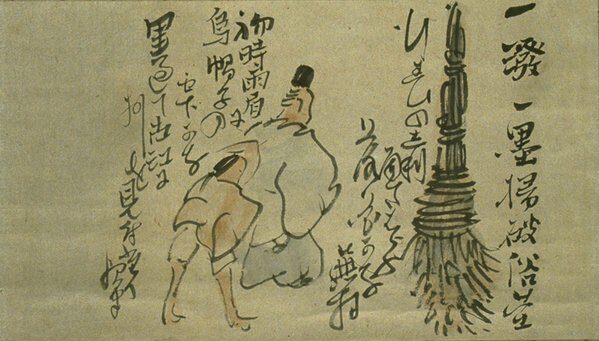Broom, Poems, and Poets
Yosa Buson

Description
Yosa Buson’s playful composition muses on a Zen idiom: A single line of ink will clear away the confusion of day-to-day life. During his lifetime, Buson spent four years as a monk at the Kenshō-ji Buddhist monastery in Kyoto. The influence of this experience on his style may be seen in the sketchy, spontaneous brushwork, which is associated with the Zen painting tradition. Brooms, Poems, and Poets is a haiga, a painting in which an image and a haiku (a short poem written in fixed verse) are combined. By merging the calligraphy with the broom, the text is transformed into an instrument for banishing confusion. In this way, Buson’s creative take on the haiga tradition speaks to the ways in which the practice of calligraphy could have an effect similar to that of attaining enlightenment.
Subject Matter:
"Buson 's paintings can generally be divided into two styles. Nanga and haiga. Haiga are paintings meant to illustrate haiku poetry. The origins of this type of Japanese painting have yet to be carefully investigated. However, it seems that Basho, who played such a central role in the formation of the haiku form, also was one of the first to paint haiga. A number of Basho's simple paintings accompanied by his haiku still exist. These amateurish efforts established the norm that haiga should convey the quality of a casual sketch rather than a fully developed painting. Buson's haiga were influenced by the skills he had developed as a Nanga painter in the Chinese style. Just as Buson's poetry possessed a more urbane, worldly air than Basho's, so his paintings seem more sophisticated and elegant.
The Michigan painting which contains the signature, Yahan, must have been painted after 1770 when he received that title, and thus dates to the last period of his life when his best paintings were produced."
There are three poems written on this handscroll, "the second of these poems is published among Buson's miscellaneous verse while the last two are found in the winter section of the Buson Kushu.
The paper here has been carefully torn away just to the left of the last line of verse and another piece of paper, colored to resemble the original, inserted. This suggests that the original painting was wider, perhaps a handscroll that was later divided into sections for mounting as a hanging scroll. The delicate colors and playful brushwork exhibited in both the paintings and calligraphy combine to demonstrate Buson's great talent in making haiga, one of the most intimate forms of Japanese painting."
Adams, Celeste, and Paul Berry. Heart, Mountains, and Human Ways: Japanese Landscape and Figure Painting: a Loan Exhibition from the University of Michigan Museum of Art. Museum of Fine Arts, 1983.
Physical Description:
"On the right side is a drawing of a straw broom accompanied by a single line of verse that reads,
Ippatsu ichiboku One stroke, one line
Soha zokujin Sweeps away worldly dust.
In a Zen fashion the poem suggests that one line of ink will clear away the confusion of everyday life. The sweeping action is materialized by the sketch of the broom.
The next poem plays upon the sweeping action mentioned above,
Yukuharu no Departing Spring's
Shiripeta harau Buttocks are brushed
Rakka kana. Of fallen flowers.
This personification of spring from whose departing hips the blossoms fall is transformed into a man in court dress who having enjoyed sitting under the flowering trees is being brushed of the petals that cling to his clothes.
The succeeding verse suggests the reason for his departure.
Hatsu shigure First shower of Autumn
Mayu ni eboshi no On my eyebrow
Shizuku kana My hat's raindrop.
The season has shifted to fall. The man stands to leave at the signal of a raindrop that has fallen from the crest of his tall hat onto his eyebrow.
The concluding poem moves the focus away from human concerns.
Sato sugite Passing the village
Furue ni yanagi o Along an old stream, a willow
Mitsuke tari. Is found."
Adams, Celeste, and Paul Berry. Heart, Mountains, and Human Ways: Japanese Landscape and Figure Painting: a Loan Exhibition from the University of Michigan Museum of Art. Museum of Fine Arts, 1983.
Usage Rights:
If you are interested in using an image for a publication, please visit https://umma.umich.edu/request-image/ for more information and to fill out the online Image Rights and Reproductions Request Form.